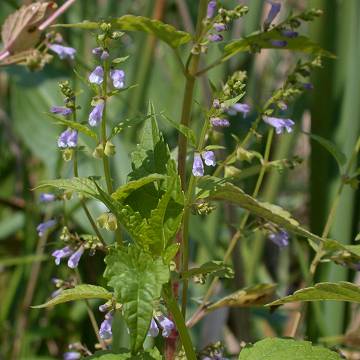

Scutellaria lateriflora - (image 1 of 6)
Taxonomy
Family: Lamiaceae
Habitat
Marshes, disturbed bogs, shaded springy sites. Swamps, meadows, swampy woods, shores, and thickets.
Associates
Moist lowlands. Grows with Scutellaria epilobiifolia in bogs.
Distribution
Newfoundland west to British Columbia, south to GA and CA.
Morphology
Rhizomatous, herbaceous perennial. Stems and leaves glabrous or glabrate. Leaves opposite, ovate or lance-ovate, with broadly rounded or subcordate base, toothed, to 8 cm long and 5 cm wide. Racemes mostly axillary or on axillary branches to 10 cm, bracteate but scarely leafy except sometimes near the base. Flowers small, up to 8 mm long, usually less, numerous in one-sided, mostly axillary, racemes, the bracts much reduced, not at all resembling the foliage leaves; calyx tube with a protuberance on the upper side; corolla blue, occasionally pink or white, to 8 mm long, the short galea evidently surpassed by the lower lip; ovary deeply 4-lobed, fruit separating into 4 1-seeded nutlets.
Notes
Flowers late June to late September
Wetland indicator: Obligate
The flowers of this species are much smaller than those of S. epilobiifolia and occur in lateral racemes arising from the leaf axils.
References
Crow, Garrett E and C. Barre Hellquist. 2000. Aquatic and Wetland Plants of
Northeastern North America
Vol. 1. Pteridophytes, Gymnosperms, and Angiosperms: Dicotyledons
The University of Wisconsin Press. Madison, WI
Gleason, Henry A. and A. Cronquist. 1991. Manual of Vascular Plants of
Northeastern United States
and Adjacent Canada. Second Ed.
The New York Botanical Garden. Bronx, NY
Swink, F. and G. Wilhelm. 1994. Plants of the Chicago Region.
Indiana Academy of Science. The Morton Arboretum. Lisle, Illinois.
|
Michael Hough © 2005 |